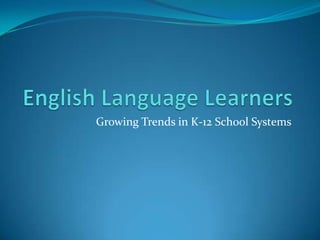
English Language Learners
- 1. English Language Learners Growing Trends in K-12 School Systems
- 2. Population growths inside the U.S. Nearly 45 years ago, an issue such as having many students in classrooms not speaking English would have been unheard of.
- 3. Placement of Children from incoming families. As more families immigrate from other countries, many of them place their children into the K-12 school systems.
- 4. What is an English Language Learner? A person who does not have English as their primary language. Common languages of ELLs found in America : Spanish, Vietnamese, Chinese, and Korean. Spanish ELLs are most abundant.
- 5. Where are these students going? Regions such as the South and Southwest have very large numbers of ELL. With Texas, Arizona, and California sharing a border with Mexico, this allows for many people to come into those states.
- 6. How fast is the ELL community growing by? Despite states like California and Arizona having large ELL populations, other states are growing as well.
- 7. How this effects schools with increasing ELLs Overcrowded classrooms Language barrier between ELL and teacher ELLs often placed into Special Education classes Attention taken away from other students Sometimes more than one language barrier is present
- 8. Schools effected limited to certain regions State of California: 1,500,000+ ELLs in schools State of Arizona: 150,000+ ELLs in schools South Carolina had the greatest increase (700%+ since 94-95) but only contains roughly 15,000 ELLs in their school systems. For native Spanish speakers, they have an easier time traveling to states like California compared to South Carolina.
- 9. Teacher Development to Serve ELLs College degree: English as a Second Language (ESL) Create an understanding of how to develop a curriculum for ELLs Requires two years of a foreign language (For Central Michigan University, at least) Close the language barrier between teachers and students
- 10. Language for Teachers and Students Teachers take foreign language classes to help communicate with students Students have afterschool meetings to learn certain English phrases Workshops with both students and teachers to practice their language skills
- 11. Conclusion With the population of English Language Learners increasing in many states throughout America it is important for school systems to be prepared. Having the teachers trained for the necessary languages spoken and helping the ELL students, this can shorten the language barrier between them.
- 12. References Pew Hispanic Center. (2006). From 200 Million to 300 Million: The Numbers behind Population Growth. Retrieved November 22, 2009 from Pew Hispanic Center website: http://pewhispanic.org/ Nettles, M. T. & Payàn, R. M. (2008). Current State of English Language Learners in the U.S. K-12 Student Population. Retrieved November 18, 2009 from Educational Testing Service website: www.ets.org http://www.daveseslcafe.com/
Notas do Editor
- Back in 1966, it was not as much of a topic. Hispanic populations were noticeable but they had a small impact on the school systems.
- Forty years later with the increase population of 100 million the ethnicity groups (labeled as Black, Hispanic, and API on the chart) have all greatly increased.
- Before we go any further, we need to ask a simple question: What is an English Language Learner? It is a person who uses another language as their first. Most commonly, ELLs in America speak Spanish, Vietnamese, Chinese, and Korean, with Spanish being the largest.
- Where do they go? This depends on where they are coming from. Since Spanish is a dominate language among ELLs, it makes sense that many of them come from Mexico. With a starting location there, we can see that places like California and Texas would have the greatest numbers.
- This does not mean that other places are not seeing an increase. With having small numbers to begin with, states like South Carolina, Tennessee, and Georgia show great percentile increase when ELLs enter their school systems.
- With more students entering the schools each year, this causes unexpected capacity limits for the schools. If the teachers are ill prepared for this interaction with these particular students, it creates a difficulty to communicate with them. Sometimes this lack of communication is interpreted as a student with special needs.
- Places like Michigan will probably not experience this kind of problem in their school systems. Even though South Carolina had their ELL population increase by over 700%, their numbers cannot compare to the massive amount of ELLs in the Californian school systems with roughly 25% of all students in their K-12 being primary speakers of other language.
- Preparation can be accomplished before entering the workforce. Course may be taken to certify teachers in handling students of other languages. Certain preparations do require college students to take a foreign language which would familiarize them with a target language of their choice.
- For teachers who are already in the workforce, taking a foreign language can help them communicate with their students. The same can be done for the target students. This interaction could help teachers and students learn from each other.
- English Language Learners will continue to increase in the classrooms of America. Though, this is limited to certain regions, it is something that should be prepared for.With a combination of teachers and students developing their language skills to work off of each other, we can be that much closer to eliminating the language differences between the two.